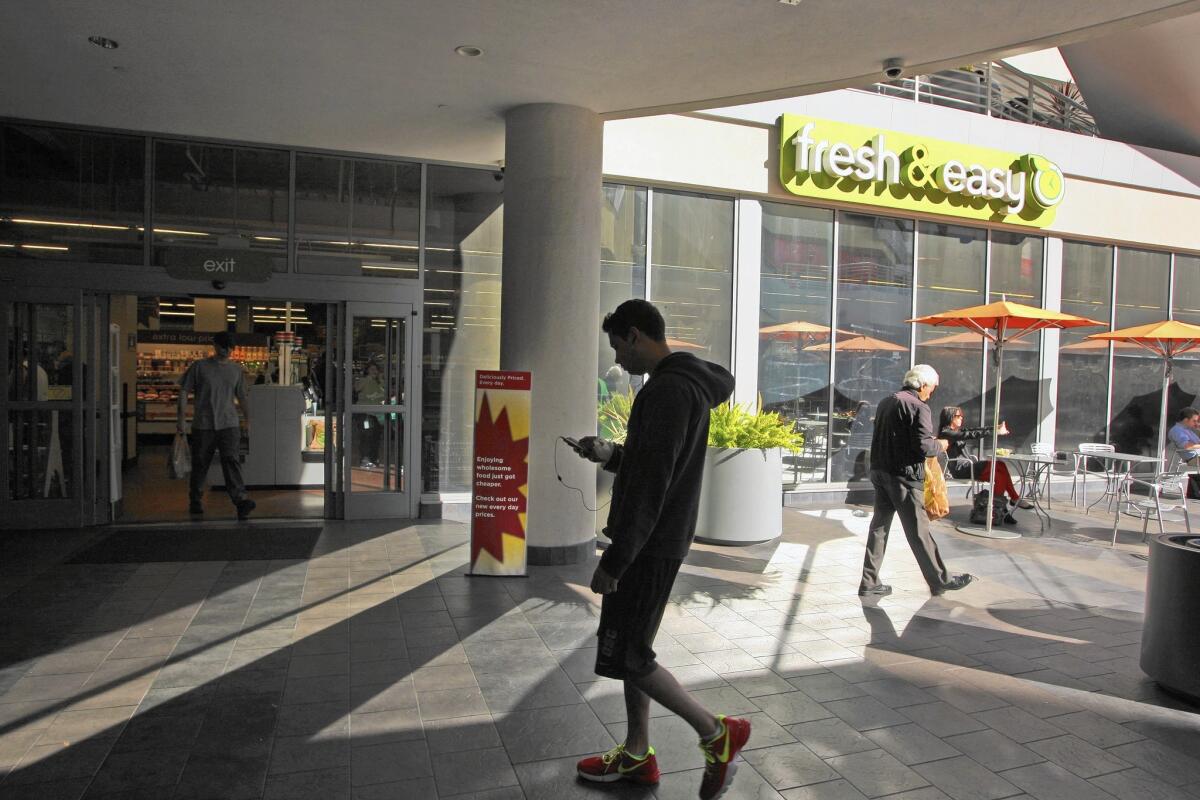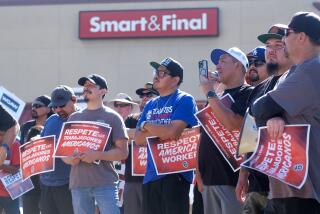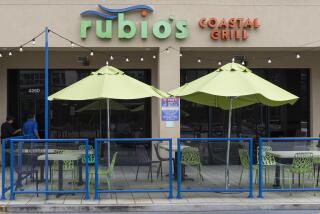Why supermarket magnate Ron Burkle couldn’t save Fresh & Easy

- Share via
When Fresh & Easy was taken over by investor Ronald W. Burkle’s Yucaipa Cos. in 2013, it seemed as if the money-losing grocery chain would finally get a chance to turn things around.
After all, the onetime box boy made his fortune in the supermarket industry, handling leveraged buyouts of chains such as Food 4 Less and Ralphs. If anyone could save the struggling company, analysts said, it would be a man known as the supermarket billionaire.
But last month, Fresh & Easy sought Bankruptcy Court protection for the second time in two years. Stores will be closed by mid-November. And employees have filed suit accusing the grocer of violating state rules that require at least 60 days’ notice for layoffs.
Despite efforts to shake up the chain under Burkle, the problems plaguing Fresh & Easy got worse, employees and analysts said.
Beyond a few experiments, Burkle never invested the money to enact a vision of attracting affluent shoppers with upscale convenience. The chain failed to communicate the stores’ mission. And cost cutting, price increases and distribution snags turned off even loyal customers.
“When they took it over, they weren’t willing to make the commitment,” said Jim Prevor, a food analyst and founder of the Perishable Pundit. “The minute they backed away, you are left with the same stores.”
Fresh & Easy’s fade-out comes as competition increases for local shoppers’ food dollars.
Big-box retailers such as Wal-Mart and Target have been expanding their food offerings. Online giants Amazon.com and Google have been rolling out grocery delivery. New rivals like Aldi are coming to town, while established competitors like Whole Foods are opening new locations — including a store in downtown Los Angeles on Wednesday.
That kind of rivalry did in Haggen, the Northwest supermarket chain that filed for bankruptcy protection in September and said it would close its stores in California, Nevada and Arizona. And Japanese convenience store chain Famima, which launched an ambitious U.S. expansion in 2005, closed the last of its local operations in October.
Yucaipa acquired more than 150 Fresh & Easy stores out of the chain’s 2013 bankruptcy, with a $120-million loan from Tesco, the British supermarket giant that sought to conquer U.S. markets in 2007 but ended up losing more than $2 billion on the venture. About 4,000 employees were able to keep their jobs.
Burkle promised changes to Fresh & Easy that “will make it even more relevant to today’s consumer.” He brought on former 7-Eleven Chief Executive James Keyes to lead Fresh & Easy’s revamp away from Tesco’s effort at British-style retailing with unfamiliar brands and minimal service.
The original vision was to transform the struggling company into a chain of healthful convenience stores, a kind of Whole Foods meets local mini-mart. Eventually, Fresh & Easy was expected to be rebranded as Wild Oats, a brand of organic and natural foods owned by Burkle.
To test the concept, Yucaipa rebranded a Scottsdale, Ariz., store as Wild Oats: A Fresh & Easy Market earlier this year. Another Las Vegas store also experimented with new ideas such as a hot food bar and an espresso bar.
But Yucaipa executives didn’t anticipate how crowded the grocery industry had become, especially among those specializing in healthful fare, analysts said. During the 1990s, when Yucaipa was “master of the universe in the supermarket sector,” there was significantly less competition, said Burt Flickinger III, managing director of consulting firm Strategic Resource Group.
Since then, Yucaipa has also diversified its investments beyond supermarkets, so it can no longer focus all of its time and money in the grocery space, Flickinger said. That lack of focus, combined with hesitation over its upscale convenience idea, doomed Fresh & Easy, he said.
Yucaipa has struggled elsewhere in the grocery industry in recent years, most notably with Great Atlantic & Pacific Tea Co., the supermarket chain better known as A&P. The investment firm increased its stake in the floundering chain in 2009 but couldn’t save it from filing for bankruptcy protection a year later. This year, the grocer tumbled into bankruptcy again and said it would sell or close its remaining stores.
“Like that situation, Yucaipa did not commit sufficient capital on Fresh & Easy,” Flickinger said. “Yucaipa bought the stores at a favorable price and thought they could operate them profitably, but it takes significant investment.”
The costs to rebrand the stores would have been hefty — perhaps $1 million a location, analyst Prevor said. And Yucaipa’s idea hinged on attracting female and white-collar shoppers, a vastly different customer base than that of the typical convenience store, which profits largely from beer and cigarettes sold to “blue-collar males,” he said.
Yucaipa did make some changes. Store hours were expanded, with some locations open until midnight and others turning into 24-hour operations. The investment firm also brought a more focused eye on the bottom line, getting rid of $5- and $10-off coupons that cost stores thousands of dollars each month.
Prices were also raised throughout the store — sometimes up to $1 on certain items — which angered many shoppers, several employees said. That drove down sales dramatically at many stores.
“They definitely seemed more business-minded than Tesco,” said one store manager, who requested anonymity to avoid endangering his severance pay. “They came in with good intentions, but pretty soon they realized it wasn’t going to be as easy as they thought.”
Under Yucaipa, Fresh & Easy managers got more freedom to order products suited to their neighborhoods — but not much, employees said.
Stores could order some produce tailored to their customers’ needs, one manager said. They were also briefly allowed to order extra products to create displays, but that authority was quickly taken away.
“It definitely seemed like they were trying things,” the manager said. “But there was a bit of confusion as to what they were doing.”
A representative for Fresh & Easy and Yucaipa declined to comment or make executives available for interviews.
Several employees said that neither Tesco nor Yucaipa invested in adequate marketing to inform shoppers about changes, or explain what made Fresh & Easy different from other grocers.
For instance, another manager said, Ralphs can be seen as a full-service supermarket, and Whole Foods has developed a reputation for upscale shopping and fresh produce. “Nobody knew what Fresh & Easy was,” the manager said.
Problems with distribution, which have bedeviled Fresh & Easy from the start, continued under Burkle. Tesco had sunk millions into an 850,000-square-foot distribution center, which put enormous pressure on the chain to quickly expand.
One team leader, who has been with the chain since its first stores opened in 2007, said Fresh & Easy always struggled with sending the right products in the right quantities. Those problems got worse under Yucaipa after suppliers were changed, the employee said.
Meats would arrive already brown, and fruits and vegetables would be spoiling. Shelves would be empty of popular items, sometimes for weeks at a time.
“Often there wasn’t a lot on the shelves,” the employee said. “Or you might have 500 boxes of cheese puffs, but no tortilla chips.”
Problems multiplied as Yucaipa cut costs, including slashing employee hours and shutting 50 stores this year in California, Arizona and Nevada.
With fewer stores, distribution can get trickier, analysts said. That’s especially true for Fresh & Easy, which built a system intended to supply hundreds of locations.
“As the volume gets smaller, it was harder and harder to sustain the proper flow through the distribution center,” Prevor said. “If you don’t have enough stores and you don’t have stores selling enough, the red-leaf lettuce might sit in a cooler for a couple of days and you’re delivering, in effect, old product.”
On the store level, employees said they scrambled to complete tasks as their hours were drastically reduced this year.
At one store, managers had to work off the clock just to clean up, an employee said. Often there wouldn’t be enough workers to keep the shelves properly stocked.
“I’d have to dig through the pallets when customers asked for something,” the employee said.
Several employees said they were angry that Fresh & Easy didn’t give notice that they were being laid off, and the company still hasn’t told all of its approximately 3,000 remaining workers when they’ll be out of jobs.
At the Eagle Rock store this week, bare shelves evoked a disaster movie scene. Many sections were completely stripped, while others had only a handful of items left.
“This is surreal,” one shopper said as she browsed.
Many customers said they would be sad to see the store close.
“I shopped here once a week,” said Julian Ledger, 46. “It’s hard to see it evaporate.”
Twitter: @ByShanLi
Twitter: @smasunaga
More to Read
Inside the business of entertainment
The Wide Shot brings you news, analysis and insights on everything from streaming wars to production — and what it all means for the future.
You may occasionally receive promotional content from the Los Angeles Times.











